The first thing we learned was that flour mill trucks run on fascism. I didn't know that. Did you? Mind blown.
Adding to the edgyness, someone has left the pumps numbers at 666, which is actually somewhat entertaining. I'd be impressed if whoever drew the swastika hadn't done it backwards. But we should at least be happy that whoever did this put Nazism in the same category as the devil. It's the folks who think the Nazis were doing Gods work that you need to watch.
Also, a fuel pump with a rotary handle is quite a nice find. It was probably outdated long before the mill closed down.
As for the actual building, what's currently standing is actually just a fraction of what once stood here. An aerial photo of the mill from 1928 shows barely any space behind the main building at all, and it also has a chimney. It barely resembles what's currently here at all.
Now, only the main building closest to the town remains, with a massive yard behind it, and one solitary warehouse right at the back. We'll check that out first because it's right here and easy to get into.
It's probably obvious because of how new it looks, but this particular warehouse doesn't feature on Victorian maps. But all of the buildings in the 1928 photograph do, as well as railways leading into the property. Evidently a lot has changed over the course of a century.
There's not really a lot to see here, but we do have the typical abandoned building penis graffiti.
In a back room of the warehouse, we found that someone has written an entire goddamn essay, seemingly titled or addressed to Tommy.
It's pretty... deep? Well, it looks like an attempt at depth anyway. Jess wasn't remotely interested in feeling her existence as absolutely fundamental through dreaming, and I only really read the whole thing later, through my pictures.
This whole thing about dreaming reads like a Marina Joyce video, circa 2016 when she started acting weird and everyone, instead of settling for the logical conclusion that maybe she just had stuff on her mind, took it off the deep end and said that she'd been kidnapped by Isis. What I'm trying to say is, it rambles.
But if you're not up for reading it all, it's basically saying that if you were able to dream vast quantities of time, like 75 years in one night, you'd eventually end up dreaming your own life, and that doing so is what would make you God, for some reason.
Hmm... Being God does look like fun, but it's a rather outdated aspiration. Creating life isn't that impressive. TV shows like Jeremy Kyle and Jerry Sringer owe their entire existince to the fact that even the stupidest examples of our species have figured out how it's done.
Anyway, it's here in its entirety if you want to read it
Onto that bloody mill, already!
Here we have the old grain storage silos. Unfortunately their ladders no longer reach the ground, so climbing them wasn't an option today.
The mill from this approach is about as pretty as Josef Fritzls feet, but in spite of this, it can't be understated that this was an integral part of its local community for over a hundred years. Some of the locals have had numerous generations of their family work here.
The actual remaining mill is divided into two buildings, connected by walkways. Once long ago a railway would have led under the walkway but this was likely removed in the 20th century when motorised transport became more common. As for how we were going to get in...
Well this looks promising!
The hole in the wall brought us into this room full of metal silos and imbecilic graffiti. I did wonder about the purpose of the silo things. My research into flour production showed me all kinds of doohickeys and gizmos, none of which looked like giant metal jars suspended upside-down. I know flour mills tend to be gravity based, dropping wheat through multiple sieves to get rid of anything that shouldn't be in it. But these metal things are largely hollow, and not at all sieve-like. Standing under one and looking directly up, one could see a hatch at the top, but really it just seems that anything dropped through that hatch wouldn't even touch the sides. which makes me wonder if they're for transfering the wheat from the storage bins into the mill. In which case there would be conveyance equipment for it all to land on.
I finally managed to find pictures of these online, and found that there would indeed be a contraption fixed over the bottom opening:
And if we look, there are little bolts around the rim that the contraption would fix to.
Apparently these are actually called tempering bins. Basically, their purpose is to use water to make the outer layer of a wheat grain easier to remove from the inner part. If tempering didn't happen, the outer layer of the wheat would get mixed in with the flour, and it would end up kinda grey.
Once the wheat has been sufficiently tempered, it's transported away and the outer shell is removed.
But if anyone truly passionate about flour production is reading this and clenching their fists in anger because I got it all wrong, I should point out, I'm not an expert. I'm just regurgitating what I find online.
There's also some anatomically questionable graffiti in here.
I love that someone has tagged their instagram name and someone else has defaced their self portrait. I have to be honest, it's always baffled me that people exploring an abandoned building feel the need to tell us where we can view their photos of it. I don't need to see your photos of it if I'm here in person looking at it.
Presumably this huge door is for vehicular access. The trucks would pull up and the flour, once bagged, would be loaded onto it, ready for distribution.
The mill dates back to 1865, but it was apparently built on the site of an even older mill. This predecessor shows up in this exact location on maps from 1825, and there was also said to be a mill here in 1733 and two mills in 1581.
However in 1865 whatever remained of these, if anything, was replaced by what is here now, or at least, the earliest version of what is here now. Bits have been added over the years, most notably in 1889. Apparently the 1889 additions were found to be structurally unsafe and so the mill temporarily used the disused brewery across the river while these issues were sorted out. Some say that these issues were never truly sorted out though. The walls are said to be two feet thick, purely because they just put another layer of brickwork in whenever there was a problem, and that structurally the building has always been unsafe.
But whether or not that's actually true, I can't confirm.
Also quite intriguingly, there are rumours of photographs depicting the mill with a wartime machine gun nest on the roof, which seems to indicate that part of it was appropriated by the military during world war two. However I haven't found any pictures, so the only evidence is word of mouth.
Check out this contraption. I have no idea what it does.
This panel on the ground was clearly used for weighing the flour before it was loaded onto the truck and sent on its way.
There's also these rather intriguing acid bins. Most of them are padlocked but the one that did open, labeled ascorbic acid, was a rather gharish orange colour on the inside.
Of course, when one talks of vats of acid, it evokes thoughts of super villain lairs, and their victims slowly being lowered in, only to re-emerge as a skeleton, with all their flesh disolved. While finding something that badass in an abandoned building would be great, the sad truth is that ascorbic acid is Vitamin C. It can be found in stuff like oranges and it's actually good for you. Flour mills use it because it strengthens and enriches the flour.
In spite of all of the surrounding decay, this sign still hangs on the wall, owing its preservation to the laminator. It outlines things that should be excluded from something called a rip-and-tip system. I have no idea what a rip-and-tip system is, but it seems to be something to do with what should and shouldn't be disposed of. The second bullet point mentions the bottom layer of any floor spilliage, meaning that if a heap of flour were to fall on the floor, any of it that wasn't actually in contact with the floor would still be useable. And of course, also excluded from this process is any flour that wasn't produced by the specific company who owned the mill. Why another flour manufacturers flour would be here is beyond me.
The fact that there's a big circle at the bottom of these big metal things suggests to me that the contraption that would have covered the opening of the silo had rested here for some time after closure.
I like the fact that the broom rack is called a "Brush Station," making it sound way more badass than it needs to be. For some reason that tickled me.
In its glory days this mill was said to be the largest, most modern flour mill in the world. In 1892, it was said to be producing 25 bags of flour an hour. I'm not quite sure how impressive that is or how it measures up to todays standards, but it must have been something to boast about, or it wouldn't have been recorded as part of the mills history.
The mills biggest renovation happened in the 1970s, when it was purchased by another company and everything inside was replaced with more modern machinery.
All of this seems to have just been dumped here, as if it was due to be cleared out and then forgotten.
These ones are still attached and there's clearly a conveyance system running underneath. Presumably the wheat was cleaned in these doohickeys before getting transported to the next step of the prduction process. Look closely and you'll see some numbered labels though, from an auction that took place in 2013. The vast majority of machinery was sold off and removed from the building during that period. It seems that all that's left is the stuff that nobody wanted.
There's a great big hole in the wall leading deeper into the mill.
The mill, it seems, has always had a flooding issue due to being on the bank of a river. Some believe that due to structural issues this portion of the building is actually slowly sinking, and will eventually bring the entire mill crashing down. This graffiti could be by a facetious mill worker joking about the flooded work conditions, or by an explorer who came here in less fortunate weather.
An American company purchased the mill either in the late 20th or early 21st Century, and subsequently decided to sell the site in 2006, due to having another one relatively nearby that met their needs better, and this one being structurally problematic. Some people have criticised this company for purchasing the mill solely with the intention of closing and selling it, costing the locals their jobs. Many of the locals are a little miffed that something that was once a defining component of their towns history and industry is now just rotting away. However some also point out that the locals had a hand in its demise. The mill allegedly had numerous complaints about the noise of trucks coming and going.
This mill could well be another casuality to the 21st Century rise of the Karens.
We found a stairway and elevator leading upwards.
There's also a small room full of junk that has seemingly fallen from the upper floors. I'm sure we'll be getting another view of this soon enough.
Time to head upstairs!
Here's the room directly above the junk pile, with a nice view of the drop.
But still, the stairs go upwards. With any luck this will take me right up to the roof.
As one ascends up the mill, the amount of pigeon crap gets difficult to ignore. This stuff carries a distinct odour, and somewhere above me I could hear the familiar flapping and cooing.
It was time to face my arch nemesis.
The drop is getting increasingly ominous too.
But on the floor above me one floorboard remains, bridging the gap, conveniently right at the foot of a ladder.
There were a few unhappy pigeons flapping around, and the stench of their excrement was pretty strong. I was certain that I needed to get through that door on the other side of the gap but I trusted the floorboard to support my weight about as much as I trust Kate McCann to babysit. I would have to find another way.
My arch nemesis was here, refusing to move too. I've hated pigeons ever since I ended up stuck in a pitch black abandoned brothel with about eight of them flapping around. They're pretty awkward creatures to explore with. This sort is particularly annoying, because rather than just fly off, it will calmly mooch around under the pretense of being unafraid, but will likely change its mind and take off as soon as I try to walk past it.
The lift is still here on the top floor, and it once had a telephone too, but this has been snapped off, leaving the cord hanging uselessly.
A small ladder leads up to the lift mechanism, but look how awkward this is! The door opens up over the ladder. That seems like a health and safety no-no.
Luckily from here the upper floors continue, and they're a bit more safe than that one-floorboard pigeon room with a huge dramatic drop.
This room is situated directly above the gigantic hollow tempering silos on the ground floor. We're actually quite high up. Those metal silos are gigantic.
There's a series of hatches here that lead down into them.
No idea what this doohickey is. It's some kind of metal frame hanging from a box.
The floor up here was still a little dodgy, and sagged a bit under our weight. But we still managed to very precariously make our way around.
If the poop on the floor wasn't a clear enough indication, this room was infested with pigeons too. Once again there were plenty of grates in the ground.
As we made our way around, the floor became increasingly diabolical.
We came across this one room where the big metal hollow things were situated above these holes in the floor that led down to more machines. Presumably the contraptions that once fixed to the bottom of the silo would then connect to the holes in the ground. It must have been a pretty cramped work environment.
There are great big chunks missing from the wall, left this way following the auction. The machinery was removed from the bottom of the silos and then lifted out through the wall. The hole in the wall was then fenced up but it seems to be pretty futile.
This floor is full of these machines with glass panels, and I haven't been able to find any flour-related gizmos remotely resembling them online, so I have absolutely no idea what they do.
Someone has scrawled "Break me" on the glass, but so far nobody has.
This ramp leads down to this room, with a sudden drop right there in front of it. Who designed this place?
This contraption is also nearby but I don't know what it does.
There's a few old conveyor belts here. They've all seen better days.
I'm actually quite impressed by the lack of vandalism. We saw a lot of graffiti in the lower floors, and there's some in the upper floors too, but it seems that the majority of wall scrawlers prefer to stay near the way out. The majority of the decay up here appears to be natural.
The whiteboard still hangs on the wall, and it's not been defaced. It's been this way since 2006, which is quite impressive.
Of course, in contrast to the relative lack of vandalism is this little office room, which has had all of the windows smashed out.
There's this really awesome control panel that has decayed wonderfully after being exposed to the elements.
Curiously the panels for each flour line are labeled "metal detectors." I guess this is to scan the flour for metal bits, which would then get removed via magnet. I don't know why metal would be among wheat when it gets turned into flour. However I probably wouldn't want to bite into a cake and find a rusty nail protruding from it either, so it's absolutely a good thing.
I guess all this is for monitoring the entire flour process.
Hidden away in a cupboard we found this safe.
There's no money in it, but someone has spray painted a pound sign.
There's a postcard here addressed to the mill, presumably from two former employees named Tich and Bill. They say that they're missing everyone, but then take that back and threaten to stay where they are forever.
I guess nobody cared enough to take this final correspondence from Tich and Bill away from the mill when it closed. I wonder what they're doing now.
At that point we'd covered this entire building, but there was still a walkway over to the next one.
From the bridge we have a wonderful view of the mills yard, and the river. You can barely see in this picture but on the other side of the river, visible just next to the top of the pole, were some people camping. As we crossed the bridge, Jess got an eyeful of naked human as one emerged from the tent in their birthday suit, not expecting to be visible to anybody. Alas, they hid before I could get a look for myself. I guess we ruined their day.
The mill owned two barges, and they delivered wheat to the mill right up until 1998 when they were finally retired.
We're now in the second building, and as before I'm going to cover it from the ground up. Fortunately there's this rather gorgeous spiral staircase leading down to the ground floor.
As with the rest of the mill, most of the machinery has been removed.
I think that this thing is a scourer, but I might be wrong. From what I can tell, there are different machines for removing different foreign objects from the wheat. Stones and bits of metal are removed early on, but these are all separate objects that just ended up getting transported with the wheat accidentally, whereas the scourer gets rid of stuff that actually adheres to the wheat, like dust, worm eggs, sand, and it also removes any wheat thats already been nibbled on. There were probably more of these down here back when the mill was operational.
Moving on upstairs, we have more floor holes and tubes, all of which I guess were attached to each other at some point.
Here's another scouring machine. The wheat would have been constantly falling down all of the pipes into various machines, until it reached ground level, at which point it would all get taken back up to the top of the building and fed through another set of pipes down the building into more various machines, until it was good clean flour. I'm sure it's a bit more technical than that, but I'm not an expert.
Here's another white board, still mostly not defaced.
There's another one of those little observation offices at the back of this room.
Someone has given the window a whack but the glass, and weapon, are still here.
I think it's worth pointing out that the very first urbex shots of this mill actually show this office to be pristine. They're about a decade old now, predating the auction and showing a mill that still looks like it could be returned to use with a little TLC. Of course back then the mill had 24 hour security so it was considered a bit of an achievement to get in, whereas by 2015 the local kids were said to have the run of the place, and it's been in steady decline ever since.
I have no idea what this space-probe looking thing is, but it resembles something called an Entoleter, which is designed to locate and remove insect infestations in wheat.
I have no idea what this thing is. Wall-E's less-popular sibling?
Moving beyond here, we were able to find an old office.
Just in case my regular antics aren't indicative enough, let me just point out that I am not a health and safety expert. However, I think having a trap door almost right in front of a regular door is just a little problematic. Sure, it's got a grate, but accidentally stepping on that could still mess up your ankle even if you don't plummet to your death.
Finally, we made it to the pigeon-infested walkway over to the first building. The wall has been removed, seemingly for the removal of the mills equipment during the auction. It's been fenced off to stop people falling to their deaths. However, it's blocked at the end. Even though it connects to the first building, it doesn't lead into it.
I also managed to snap a shot of Jess from the top of the ladder, standing next to what used to be the wall. Snapping Jess from above seems to be a recurring theme now...
I didn't particularly want to climb up through the ladder because my arch nemesis, the pigeon was there, sitting casually on some rubble, making vague pigeon noises that sounded an awful lot like "I'll peck you and shit on your face if you come up this ladder."
I would have to find an alternative route.
We'll come back to the connecting bit after we check out the floor above.
One of the last remaining pieces of machinery is this gigantic industrial rotary sieve. It's just another machine for cleaning wheat and using sieves. This room was probably full of them once.
Okay, so this is the connecting bit again, with the hole in the ground being the top of the ladder that I photographed Jess from earlier. The pigeons have long gone, but they'll be back... Even so, this corridor still doesn't lead into the other building that it physically connects to, so we had to go even higher.
We're back where we started! The earlier stairway brought me out on the other side of this great big hole. From here it will be pretty easy to get up onto the roof.
Finally, with one last stairway we were up on the roof, and it was nice and flat, albeit with chunks missing.













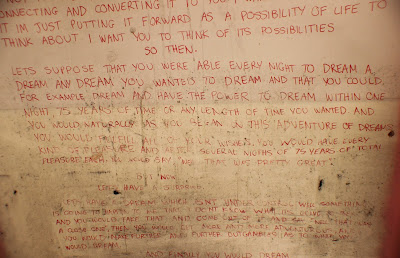

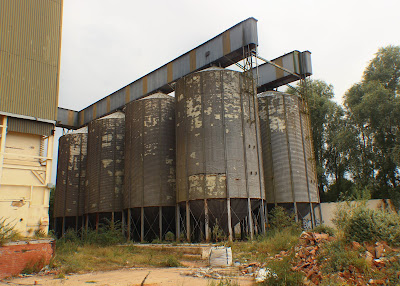






















































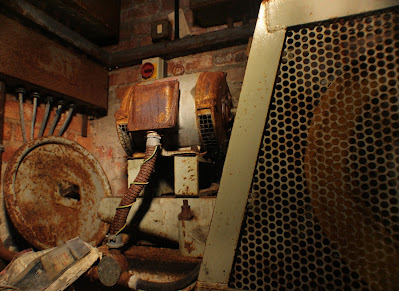







































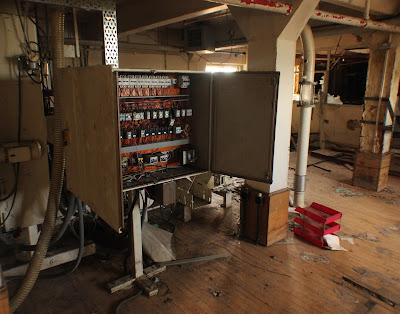




















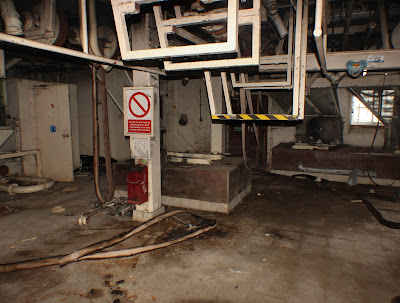











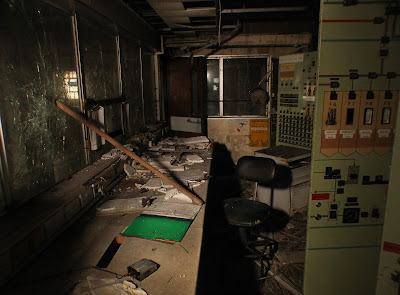
































































No comments:
Post a Comment